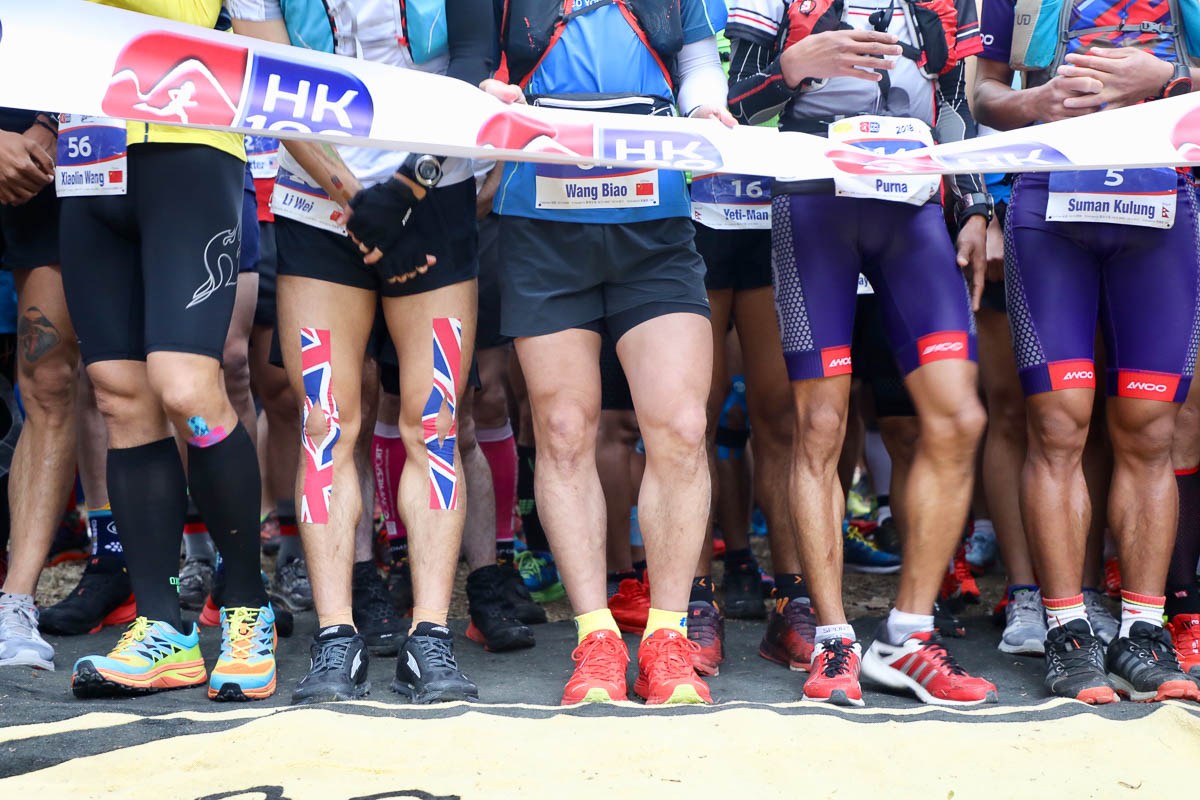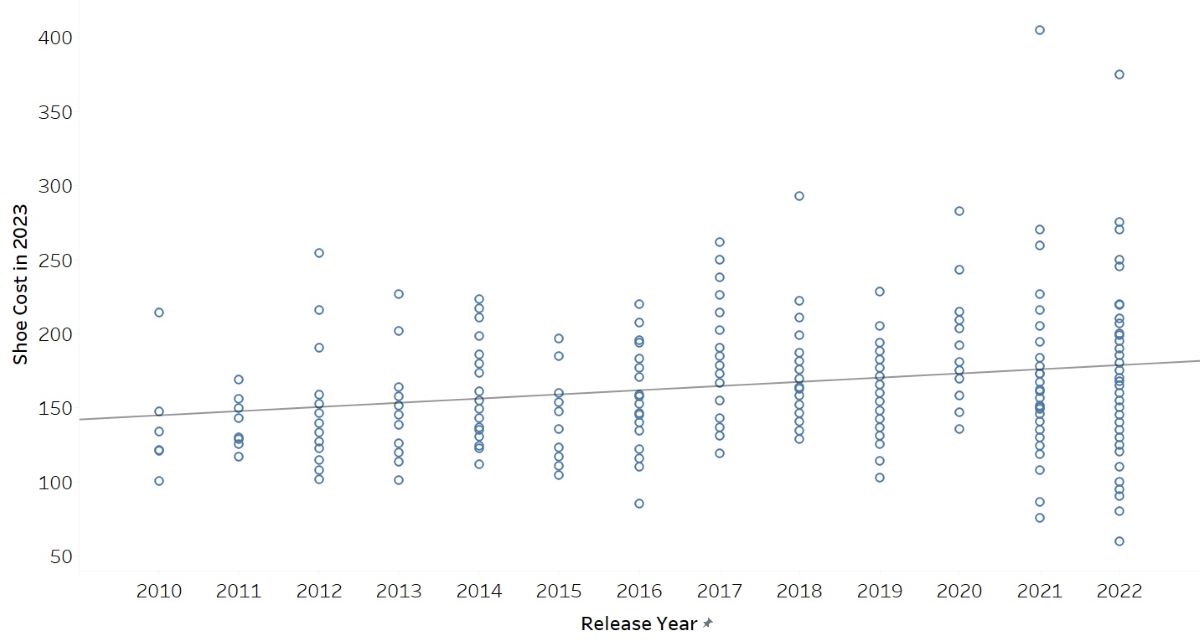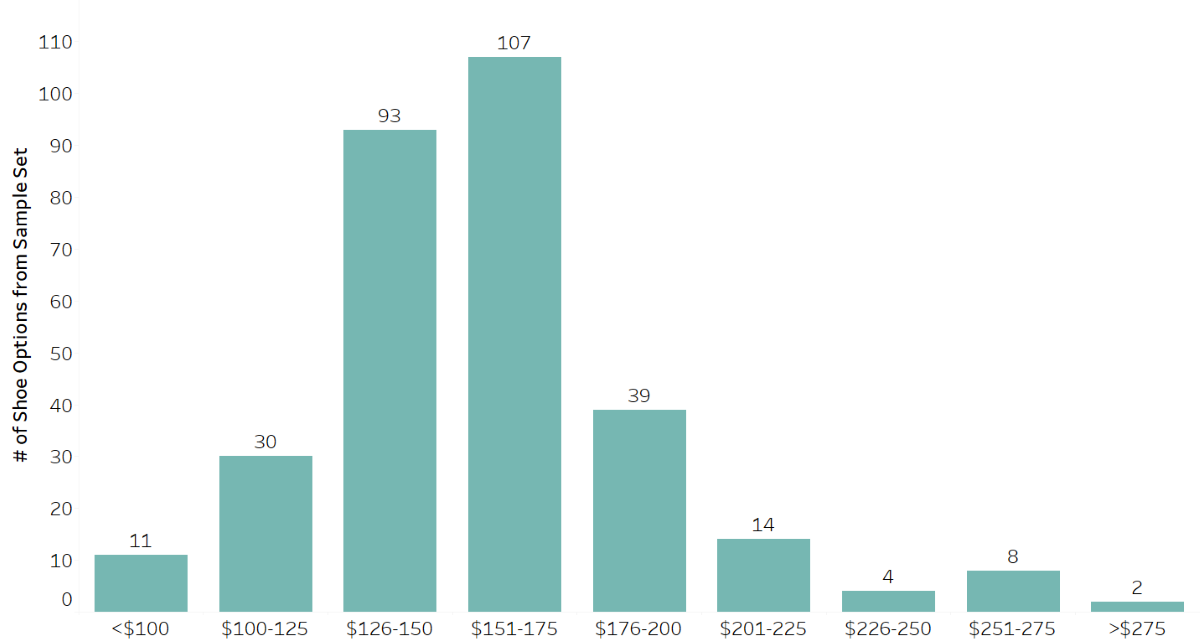Whether it’s groceries, mortgage payments, or your discretionary spending, you’ve likely noticed that a lot of things cost more in 2023. Do best trail running shoes also cost more?
According to our statistical analysis, the answer is yes. Trail running shoes cost more now than they did in the past. We all know inflation is at work on the price tag increases we see everywhere, but when adjusted for inflation, trail running shoes still cost more now than in the past.
In this article, we dive into the cost increase of trail running shoes over time. We also use the data to speculate on the reasons for this and consider whether price increases have been consistent across all types and models of shoes. Let’s dig into the data.

Squeaky clean trail shoes at the start of the 2018 Vibram Hong Kong 100k. Photo: iRunFar/Meghan Hicks
First, the Methodology
This analysis is based on a sample dataset I created. I generated a list of the trail running shoes reviewed by iRunFar on this website and shoes the iRunFar team saw twice-yearly at the Outdoor Retailer trade show from 2010 through to the present. I supplemented that list with another 170 models of shoes that iRunFar hasn’t reviewed and that we didn’t look closely at the trade shows, but shoes we know have been on the market through the years. The result was a dataset of 775 shoes from 51 brands released since 2010.
Next, I noted the release year of every shoe reviewed by iRunFar. For the other non-reviewed shoes, I looked online for either release dates or the earliest (readily findable) review date. To be transparent, using review dates on other websites is an imperfect method for determining when a shoe came out because some websites “refresh” their publication dates for review articles to appeal to search engine algorithms, which privilege recent web content.
Finally, I indexed shoe prices for inflation to give every shoe a cost in 2023 dollars. Because iRunFar lists prices in U.S. dollars in its reviews, I used U.S. currency for this analysis. While inflation has increased globally recently, I used the rate of inflation recorded in the U.S. for consistency. The annual rate of inflation in the U.S., for example, jumped from 1.4% in 2020 to 7% in 2021.
How Much Do Trail Running Shoes Cost?
Within this sample dataset, a pair of best trail running shoes purchased any time since 2010 cost an average of $158.60 after indexing for inflation. From 2010 to 2017, an average pair of trail shoes cost $155.70. Since 2018, the average has climbed to $160.20.
That means that, after controlling for inflation, your shoes cost, on average, $4.50 more than they used to.
That is based on the manufacturer’s suggested retail price, so your own experience buying shoes may differ based on such factors as whether you:
- Favor a particular brand
- Chase the discounts or support your local running store (not that the two are mutually exclusive)
- Tend to buy a new model of shoe as soon as it comes out or wait until it goes on sale
- Stocked up on your favorite make and model of shoe a while ago and are still set for another five years
To some degree, paying more for trail running shoes in 2023 may be inevitable. Shoes are costing more, on average.
As we prepared our dataset, we also found multiple occasions where manufacturers had raised a shoe’s suggested retail price compared to when it was first released. To offer just one example of this, iRunFar was originally told the retail price of the La Sportiva Ultra Raptor II would be $130, but it’s now listed online with a manufacturer’s suggested retail price of $165.
It’s not all bleak, though. While many shoes with higher price points are boasting new features, and there are more options than ever across a wide price range.
Trail Running Shoe Cost Options in 2023
To appreciate the increasing options and prices for trail running shoes, it’s helpful to compare your current shoe options to those of yore. In the chart below, every circle represents a model of shoes from our dataset. There were more shoes on the market in 2022 than in 2010 by a long shot.
While the trend line is gradually sloping upward over the years (even though the prices are all adjusted for inflation), the chart shows that are plenty of models available at the lower end of the price spectrum.

A scatterplot showing the range of trail running shoe prices over time. Each circle shows one shoe from iRunFar’s dataset on trail shoes from 2010 to the present, plotted by their cost on the X axis and release year on the Y axis. Image: iRunFar/Mallory Richard
Dozens of Shoe Options Exist Below the Average Price
Increases to our other household expenditures may squeeze our shoe budget, but there’s some good news in the chart below. There are dozens of models of trail shoes out there that might be considered budget-friendly. If you consider shoes released since 2021 (which is a rough way of estimating what’s currently on the market), you can set your budget for $150 or less and have over 100 models of shoes to choose from.
If you’re one of the runners who is investing in the newest and most advanced shoes, you can take some pride in being at the tip of the bell curve. If you’re one of the runners buying your shoes for under $150, you can show this distribution chart to your family to show off the tempting, pricier shoes you are resisting.

A histogram showing the range of trail running shoe prices through time. Using iRunFar’s dataset on trail shoes from 2010 to the present, the shoes are organized by cost ranges on the X axis and the number of shoe models on the Y axis. Image: iRunFar/Mallory Richard
Waterproofing Technology Is Not to Blame for Cost Increases
While the cost of trail running shoes has generally been increasing over the past decade, what I call the “Gore-Tex premium” has remained relatively stable. Every year, several models of shoes are available with both mesh and Gore-Tex or waterproof equivalent uppers. The Gore-Tex option costs more, but the value of that premium has been fairly consistent over the years, and you can expect to pay an average of $25 more for the Gore-Tex version of your favorite trail shoe.
Most often, brands charge $30 more for the Gore-Tex edition of a given model, but that can range from $10 (for the Hoka Challenger 6 GTX, for example) to $40 (for the Hoka Speedgoat 5 GTX, as an example).
New Technologies and Shifting Priorities Are Driving Price Increases
In 2017, Altra released the Altra Timp IQ. With a manufacturer’s suggested retail price of $220 ($261.80 in 2023), it was the most expensive shoe in my dataset at that time. From 2018 onward, my dataset contained 18 models of shoes that cost at least that much. Those models boasted features such as carbon plates, innovative materials on the sole and upper, sustainability-conscious materials and business practices, and/or limited-edition status.
The year 2022 was big for small brands breaking into the trail running scene. You may have read iRunFar’s coverage of shoe releases by Speedland and Nnormal, plus news about brands like Craft and Norda. All are specialty brands that produce high-end, high-performance shoes and are priced accordingly. Those four brands alone have an average shoe cost of $241.50 from among the shoe models in our dataset, and there are arguably other brands that belong in this same group.
These shoes contribute to increasing the average cost of trail running shoes in our dataset. The chart below plots a line for each of the following:
- The most expensive shoe iRunFar tracked each year since 2010
- The median (middle) shoe price for each year
- The cheapest shoe iRunFar recorded for each year
You’ll notice the most pronounced shift since 2010 has been the rate at which the most expensive shoe of the year has increased.

A line graph showing the most expensive shoe iRunFar tracked each year since 2010, the median (middle) shoe price for each year, and the cheapest shoe recorded for each year. Image: iRunFar/Mallory Richard
The most expensive pair of shoes iRunFar reviewed for 2011 cost $169 when adjusted for inflation, whereas Speedland released shoes in 2021 and 2022 that sold for $375. When adjusted for inflation, the 2021 Speedland SL:PDX would cost $405 in 2023 dollars. The rise of the pricier, high-performance shoe isn’t necessarily a bad thing. They are giving trail runners new options. Some runners place a premium on performance, innovation, and sustainability, and several brands are investing in those. Whether you are willing to invest an average of $241.50 for your next pair of shoes comes down to your own resources and priorities.
The rise of boutique brands reflects new customers and some consumers’ shifting tastes. Speaking of shifting tastes, as I re-read iRunFar’s archive of shoe reviews, I was reminded that minimalist shoes were far more common in previous years. I speculate the shift away from minimalist footwear plays a role in rising shoe prices, as minimalist shoes were generally priced lower than later models with thicker soles or even carbon plating.
One fun case in point was the Inov-8 Evoskin that iRunFar reviewed in 2011. I excluded it from my sample set because that particular model was not a trail shoe, but its $60 price point is certainly appealing these days when my cat’s share of the weekly grocery bill is more than that.

Running in the inov-8 X-Talon Ultra 260 V2 trail running shoes in Colorado. Photo: iRunFar/Eszter Horanyi
Conclusion
If you’ve bought shoes in the last year, this article’s findings may simply confirm what you already know: Like so many of our other yearly expenditures, trail running shoes are costing more.
We now know, though, that the price increases of trail running shoes can be only partially attributed to inflation. There are other factors at work in bringing up those price tags, about which we’ve speculated a few.
Seeing the average cost and the distribution of price points may help you budget accordingly for your next pair of shoes, help you weigh the merits of different options, or give you something to talk about on your next long run. If nothing else, you’ve helped me pay for another week of cat food, so I appreciate you reading.
Call for Comments
- Have your shoe-buying habits or priorities changed over the years?
- What are your thoughts on the current offerings for trail running shoes?
- Have you, in fact, found yourself discussing this topic or any other Running the Numbers articles on your long runs?
